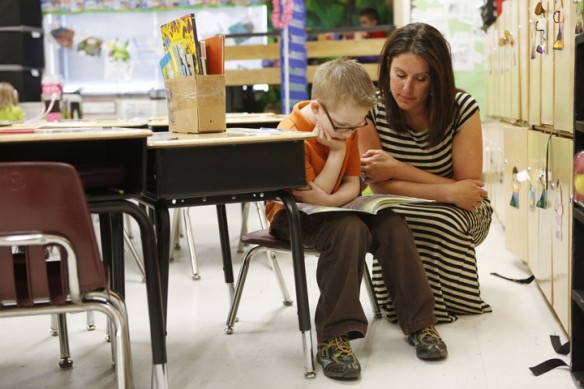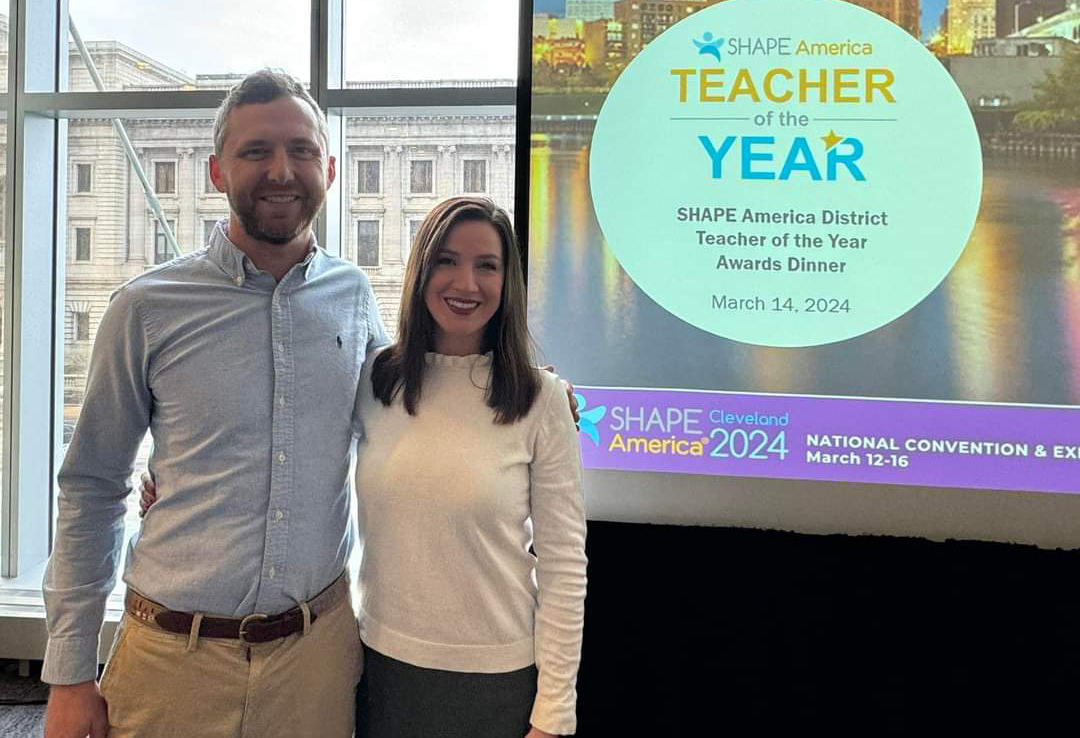
Amy Keadle listens to 1st-grade student Cooper Tuerk read during her class at Tilden Hogge Elementary School (Rowan County).
Photo by Amy Wallot, April 8, 2013
By Susan Riddell
susan.riddell@education.ky.gov
When Amy Keadle – like many current teachers – worked on spelling lessons as a child, she had a grade-level spelling book and regular tests. She said if students didn’t pass those tests, they simply moved on to the next list along with the rest of the class.
But Keadle, a National Board Certified Teacher who teaches 1st grade at Tilden Hogge Elementary School (Rowan County), doesn’t do it that way now.
“I have four different spelling lists,” Keadle said. “The lists are differentiated according to student developmental stages. If students do not show understanding of the word pattern, they study the pattern again the following week.”
Theresa Fisette, who teaches kindergarten at Lincoln Elementary School (Dayton Independent), remembers being taught grammar in 5th grade. Now, students in kindergarten get those lessons, too.
Fisette introduces her students to nouns, verbs, adjectives, prepositional phrases and correct punctuation through their reading and writing.
“We might have a mini-lesson about nouns after reading a story, such as The Cat in the Hat or a discussion on prepositional phrases during a math lesson in which we read the book, Mouse,” Fisette said. “We might emphasize spacing between words or correct punctuation through our morning message or in their daily journal writing.
“The concepts are integrated throughout the curriculum instead of taught as a separate subject,” she added.
That’s happening more and more as expectations of early primary students are changing under the Kentucky Core Academic Standards (KCAS).
Even before Kentucky approved the standards, teachers were veering away from outdated trends in K-2 grammar and spelling lessons.
In particular, spelling words correctly isn’t emphasized during the early primary years as it was decades ago – although it’s still a very important part of the learning process, educators say.
Kentucky Department of Education (KDE) literacy consultant MK Hardaway said, based on the KCAS, kindergarten students should be able to write letters for most consonant and short vowel sounds and be able to spell simple words phonetically.
First-grade students should show a natural progression from there.
“In kindergarten, a correct beginning and ending sound may be enough, for instance,” Hardaway said. “In first grade, they should have a better grasp and can use known patterns to spell other words. Since they know ‘man,’ they can spell ‘can’ and ‘fan.’”
Erin King, a 1st-grade teacher at Silver Grove (Independent) School, agrees that the developmental progression is crucial.
“It is more important to me that the students are using the phonics skills we have learned in class to spell unfamiliar words,” King said. “This shows me they are able to take the skills and apply them.”
Hardaway said it’s important that teachers don’t overwhelm young learners with the demand for proper spelling because, at that age, it’s imperative that teachers foster a love of writing, much like a love of reading.
If students are constantly told they are spelling words wrong, they are more prone to becoming discouraged in their writing.
“The early feeling of success is critical for children to be willing writers,” Fisette said. “You will usually be able to tell when a child is ready to take some constructive criticism, and you have to be selective in how much you correct. While I want my students to persevere, I do not want them to reach the level of frustration and quit.”
When she does choose to correct her students, Fisette said she reads back what a student has written using the sounds from letters and consonants consistent with their words. They almost always tell her she’s wrong.
“We try to find the sounds that would make the words say what they want them to say,” Fisette said. “We can correct incomplete sentences and problems with verb agreement in the same manner.”
Keadle emphasized the importance of gauging students individually and basing expectations on them accordingly. When she assesses students in spelling, she makes sure that they stay on pace with the patterns she’s covered like consonant-vowel-consonant words, silent ‘e’ vowel patterns and vowel team patterns.
She said that if she sees basic spelling mistakes, she will guide a student to the right spelling rather than make a bold correction.
“I might say, ‘This word is on the word wall. Can you find it and spell it correctly?’ or ‘I see that you know there is a long vowel sound in the word fear. You spelled it f-e-r-e. What other vowel patterns make the long ‘e’ sound?’” Keadle said.
King tries to make sure her sight words assessments are fun for the students. She will routinely give them letter magnets and baking sheets before calling out words for them to spell on the metal sheets. Or she might give them dry erase markers and let them spell called out words on their desks.
“The kids love writing on their desks, and it wipes off easily,” King said.
Like the technique Fisette uses for spelling corrections, one of the better approaches for correcting students in grammar and writing is to simply read back what a student has written, and typically the student will pick up on any mistakes themselves by hearing how the words sound together.
As with the assessments, standard writing prompts can be structured to engage early primary students and further develop a love of writing.
Giving students choices in their writing will lead to more ownership of their work, the teachers said.
“I give students a lot of choice during writing,” King said. “If the student is interested in the topic, he or she will be excited to learn about it and share with others.
“All students enjoy telling stories, therefore you have to find out what interests them and get them excited to share with others through their writing.”
King said her students seem to enjoy informative and exploratory writing the most. Fisette said her students enjoy list writing. They will list off toys they have in their room, animals that are mammals or items they would need to buy to make their favorite sandwich.
Her students also enjoy opinion pieces like: should Goldilocks get in trouble for sneaking into someone’s home or why should they go outside for recess today?
If a student expresses a disdain for writing, Fisette will encourage the student in a positive manner.
“Praise is the single most effective way for me to reach a student who does not want to write,” she said, adding that praise can come from fellow students, other staff in the room or even a principal or custodian.
“I try to be very specific in my praise, such as, ‘I love the way you described the dog. You drew a picture for me in my head,’ or ‘You are such a good writer. I could read it because you wrote all the sounds.’”
Telling a student you wonder what’s going to happen next also works well, Fisette said.
Keadle said students who don’t enjoy writing tend to feel that way because they don’t see the purpose in it.
“If writing is purposeful and authentic, students eagerly participate,” Keadle said.
MORE INFO …
MK Hardaway, mikkaka.hardaway@education.ky.gov, (502) 564-2106, ext. 4514
Theresa Fisette, theresa.fisette@dayton.kyschools.us, (859) 292-7492
Amy Keadle, amy.keadle@rowan.kyschools.us, (606) 784-4604
Erin King, erin.king@silvergrove.kyschools.us, (859) 441-3873








Leave A Comment